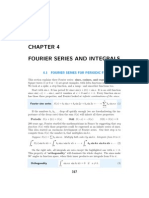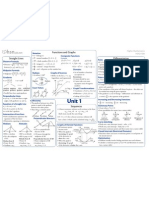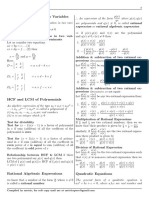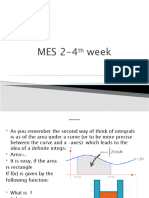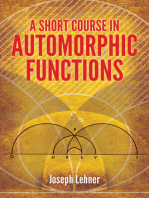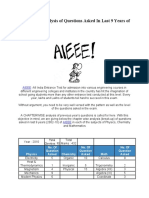Math 141 Exam Summary Sheet
Math 141 Exam Summary Sheet
Uploaded by
jackCopyright:
Available Formats
Math 141 Exam Summary Sheet
Math 141 Exam Summary Sheet
Uploaded by
jackOriginal Description:
Copyright
Available Formats
Share this document
Did you find this document useful?
Is this content inappropriate?
Copyright:
Available Formats
Math 141 Exam Summary Sheet
Math 141 Exam Summary Sheet
Uploaded by
jackCopyright:
Available Formats
Math 141 Equation Sheet
MATH 141 EQUATION SHEET
SIMPLE INTEGRATION FORMULAS
Kdx = Kx + C ( K and C are constants)
x n+1
=
+C (n
x
dx
n +1
x dx = ln x + C
1 )
cosines (or sines) and solve using
substitution.
If both m and n are even we use the
formulas
1 cos 2 x
1 + cos 2 x and
sin 2 x =
cos 2 x =
2
2
Second case:
dx = e x + C
SUBSTITUTION
f (u ( x)) u ( x)dx = f (u ( x)) + C
INTEGRATION BY PARTS
udv = uv vdu
FUNDAMENTAL THEOREM OF CALCULUS PART I
u ( x)
d
f (t )dt = f (u ( x)) u ( x)
dx a
FUNDAMENTAL THEOREM OF CALCULUS PART II
tan
x sec n xdx
2
If n is even we isolate sec x we then
change the remainder of the secants to
tangents using the formula
sec 2 x = 1 + tan 2 x and use substitution
( u = tan x )
If both n and m are odd we isolate
sec x tan x then change the
remainder of the tangents into secants
using the formula tan 2 x = sec 2 x 1
and use substitution ( u = sec x )
Note that in the second case the case where
n is odd and m even is not covered, this case
is dealt with case by case.
TRIGONOMETRIC SUBSTITUTIONS
For x 2 a 2 we use the substitution
For x 2 + a 2 we use the substitution
f ( x)dx = F (b) F (a)
where F ( x ) is an antiderivative of
f (x )
IMPROPER INTEGRALS
An integral
f ( x)dx
is an improper integral if it
satisfies at least one of the two following
conditions:
a or b are or
f is undefined for any point in the interval [a,
b]
In the case of an improper integral we replace a
or b (or the point in between, or both) with a
letter, evaluate the integral then take the
appropriate limit. If we get a finite answer the
integral is called convergent otherwise its a
divergent integral.
tan
x sec n xdx .
First case:
sin
x cos n xdx
If m or n is odd we isolate
cos x
or
x = a tan
For
a2 x2
x = a sin
AREA BETWEEN TWO CURVES
The area between two curves is given by a
definite integral. Say the area in question is
between
to:
we use the substitution
x = b . Its value is equal
" higher curve" " lower curve" dx
A
+ ...
( x a)
For each factor of ( x 2 + a ) we put
Ax + B
+ ...
( x 2 + a)
For each factor
VOLUMES
The main formula for finding the volume
generated by the revolution of an area over an
b
axis is:
R2 r 2d ?
a
If the axis is parallel to the x-axis then its a dx, if
the axis is parallel to the y-axis its a dy.
AVERAGE VALUE OF A FUNCTION OVER AN
INTERVAL
interval
[ a, b ]
is given by 1
f (x )
b a a
f ( x)dx
over the
.
LENGTH OF A CURVE
be a function continuous on [a, b]
differentiable on (a, b). The arc length of the
curve from x = a to x = b is given by
Once we have the denominator factored (and
of course the degree of the numerator is less
than the degree of the denominator AND
substitution failed) we do the following:
For each factor of ( x a ) we put
and
By higher curve I mean the one more positive.
Let
x=a
The average value of a function
PARTIAL FRACTIONS
TRIGONOMETRIC INTEGRALS
In this part we turn out attention to integrals of
two forms sin m x cos n xdx and
x = a sec
Once we have the partial fractions we proceed to
the common denominator, then to finding the
values of the constants and finally we compute
the integral of each of the partial fractions we
found.
(L) n
we put a partial
fraction for every power going from 1 to
n
Ex: For ( x 2 +3) 3 we put the partial fractions
Ax + B
Cx + D
Ex + F
+
+
( x 2 + 3) ( x 2 + 3) 2 ( x 2 + 3) 3
L = 1 + ( f ( x)) 2 dx
a
If the roles of x and y are reversed we use the
formula L =
1 + ( g ( y )) 2 dy
AREA OF A SURFACE OF REVOLUTION
Let
be a function continuous on [a, b]
differentiable on (a, b) such that f ( x ) 0 on
[a, b]. The surface area S of the surface of
revolution generated by revolving the graph of f
on [a, b] about the x-axis is given by
b
S = 2 f ( x) 1 + ( f ( x)) 2 dx
a
sin x , we change the remaining of the
Weve helped over 50,000 students get better grades since 1999!
Need help for exams?
Check out our classroom prep sessions - customized to your exact course - at www.prep101.com
(If the function g ( y ) on [c, d] is revolving about
the y-axis then the surface area S of the surface
of revolution is given
by
S = 2
g ( y)
1 + ( g ( y )) dy
2
SEQUENCES AND SERIES
Given a series
The Integral test
the series
a
n =1
PARAMETRIC EQUATIONS
FIRST DERIVATIVE
1.
and the improper integral
SECOND DERIVATIVE
The Comparison Test
convergent.
If
an
is given by L =
t2
t1
dx dy
+
dt dt
and
bn
n is
x = r cos , y = r sin
The Root Test
1.
n is divergent.
, If
lim n a n < 1 , the series is absolutely
n
convergent.
and
2.
lim n a n > 1 , the series is divergent.
3.
lim n a n = 1 , the test is inconclusive
n
n
The Alternating Series Test
series of the form
y
r = x 2 + y 2 , = tan 1
x
AREA OF THE REGION BETWEEN THE ORIGIN AND
THE CURVE
(1)
1
A = r 2 d
2
(1)
n =1
an .
a n is convergent if:
1.
lim a n = 0 and,
2.
a n +1 < a n
for all n. (The series is
decreasing)
Absolute and Conditional
Convergence
Given a series
n it is either
LENGTH OF CURVE
1.
absolutely convergent if
If r = f ( ) has a continuous first derivative for
and if the point P (r , )
2.
convergent
conditionally convergent if
a
a
is
n is convergent but
traces the curve exactly once as runs from
to then the length of the curve is given by
a n+1
= 1 , the test is inconclusive.
n a
n
lim
Given a series
bn is
both converge or both diverge
n =1
From rectangular to polar coordinates:
3.
We apply this test to alternating series i.e.
From polar to rectangular coordinates:
r = f ( ),
If lim a n = c > 0 then
3.
POLAR COORDINATES
divergent then
The length or the arc of the curve between two
t2
convergent then
points corresponding to parameter values t1 and
a n+1
< 1 , the series is absolutely
n a
n
lim
a n+1
We apply this test to series of positive terms.
The comparison test can be applied in 3
forms:
1.
If
an bn and bn is
ARC LENGTH OF A PARAMETRIC CURVE
, If
2.
lim
> 1 , the series is divergent.
www.prep101.com
a
2.
convergent.
f ( x)dx both converge or both diverge.
dy
dy
= dt
dx dx
dt
d dy
d 2 y dt dx
=
2
dx
dx
dt
3.
dr
r2 +
d
d
n is divergent
divergent if
n is divergent.
RATIO TEST
Our Course Booklets - free at prep sessions - are the Perfect Study Guides.
You might also like
- Intermediate Calculus Study Sheet (MATH 262)No ratings yetIntermediate Calculus Study Sheet (MATH 262)0 pages
- Single Variable Calculus Assignment HelpNo ratings yetSingle Variable Calculus Assignment Help11 pages
- SMP 16-19 Mathematics - Revision Notes Unit 5 - Calculus MethodsNo ratings yetSMP 16-19 Mathematics - Revision Notes Unit 5 - Calculus Methods2 pages
- Lagrange Multipliers Can Fail To Determine Extrema: Acknowledgment100% (2)Lagrange Multipliers Can Fail To Determine Extrema: Acknowledgment3 pages
- Linear Equations in Two Variables: Quick Reference, STD: X 1No ratings yetLinear Equations in Two Variables: Quick Reference, STD: X 14 pages
- Mathematics Revision of Formulae and Results: Surds Co-Ordinate GeometryNo ratings yetMathematics Revision of Formulae and Results: Surds Co-Ordinate Geometry5 pages
- Notes_SingleVariable,Limit,Continuity,DifferentiabilityNo ratings yetNotes_SingleVariable,Limit,Continuity,Differentiability19 pages
- Directional Secant Method For Nonlinear Equations: Heng-Bin An, Zhong-Zhi BaiNo ratings yetDirectional Secant Method For Nonlinear Equations: Heng-Bin An, Zhong-Zhi Bai14 pages
- Math 432 - Real Analysis II: Solutions To Test 1No ratings yetMath 432 - Real Analysis II: Solutions To Test 15 pages
- Price Convergence: Exchange Rates Commodities Price DiscriminationNo ratings yetPrice Convergence: Exchange Rates Commodities Price Discrimination1 page
- Free Pricing Approach For Bonds: Discounted Cash FlowsNo ratings yetFree Pricing Approach For Bonds: Discounted Cash Flows1 page
- Diminishing Opportunities and Broadening of Strategies: EarlyNo ratings yetDiminishing Opportunities and Broadening of Strategies: Early1 page
- Trading Strategies: List of Major 1998 TradesNo ratings yetTrading Strategies: List of Major 1998 Trades1 page
- AP Calculus AB - Ultimate Guide Notes - KnowtNo ratings yetAP Calculus AB - Ultimate Guide Notes - Knowt29 pages
- ADA169794 - Second International Conference On Numerical Ship Hydrodynamics - September 1977 - University of California, BerkeleyNo ratings yetADA169794 - Second International Conference On Numerical Ship Hydrodynamics - September 1977 - University of California, Berkeley407 pages
- Review For Calculus II Test I - Fall 2024No ratings yetReview For Calculus II Test I - Fall 20243 pages
- Chapterwise Analysis of Questions Asked in Last 9 Years of AIEEENo ratings yetChapterwise Analysis of Questions Asked in Last 9 Years of AIEEE5 pages
- Local Stress Concentrations in Imperfect Filamentary Composite MaterialsNo ratings yetLocal Stress Concentrations in Imperfect Filamentary Composite Materials18 pages
- Senior Preparation-Additional Mathematics Additional Mathematics (Syllabi)No ratings yetSenior Preparation-Additional Mathematics Additional Mathematics (Syllabi)25 pages
- Linear Algebra and Calculus 2019 Syllabus Ktustudents - inNo ratings yetLinear Algebra and Calculus 2019 Syllabus Ktustudents - in8 pages
- Math 205 Series and Vector Calculus 3 3 1No ratings yetMath 205 Series and Vector Calculus 3 3 13 pages
- Edexcel GCE Core 1 Mathematics C1 Jan 2006 6663 Mark Scheme100% (1)Edexcel GCE Core 1 Mathematics C1 Jan 2006 6663 Mark Scheme13 pages
- A Second Course in Analysis: M. Ram MurtyNo ratings yetA Second Course in Analysis: M. Ram Murty346 pages
- Intégration (Chap. I - I V) - by N. Bourbaki. (Actualités ScientifiquesNo ratings yetIntégration (Chap. I - I V) - by N. Bourbaki. (Actualités Scientifiques7 pages





















